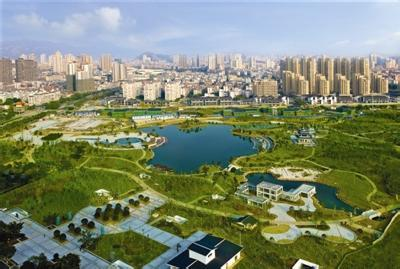Progress and Gaps in Chinese Cities' Low Carbon Endeavors
Progress and Gaps in Chinese Cities' Low Carbon Endeavors By YANG LI

Low carbon development in China's cities is critical to achieving the nation's climate mitigation targets.
AS hubs of economic activity and employment that attract inward migration from surrounding rural regions, cities generate the biggest share of China's total energy consumption and energy-related CO2 emissions.
In 2014, 749.16 million people made their homes in urban areas, accounting for 54.77 percent of the total population. This is a main reason why industrial-oriented energy and activities are predominant sources of pollution in most cities. Accelerated urbanization, moreover, will also make buildings and transportation potentially high-emission sectors.
The planned 2020 urbanization rate is 60 percent, equivalent to an annual average growth rate of almost 1 percent. This will inevitably lead to a parallel annual increase in total energy consumption. Low carbon development in China's cities, therefore, is critical to achieving the nation's climate mitigation targets.
Municipal governments have central decision-making authority with regard to local economic development and public services that influence GHG emissions. The policies and actions they take to include low carbon development into city administration hence constitute a significant challenge. To this end, the National Development and Reform Commission (NDRC) has launched a low-carbon pilot scheme in 36 cities of six provinces which, through practical activities, identifies appropriate measures and patterns to be generalized in the promotion of urban low-carbon development.
The U.S.-China Climate Leaders' Summit in 2015 established the Alliance of Peaking Pioneering Cities (APPC), which includes nine cities - Guiyang, Beijing, Jilin, Wuhan, Shenzhen, Guangzhou, Zhenjiang, Jinchang and Yan'an – out of the pilot 36 low carbon cities.
They are committed to achieving peak carbon emissions earlier than China's national goal through ambitious climate change actions. In general, therefore, low carbon policies, programs and measures aimed at Chinese cities have been preliminary established. They are largely characterized by:
1) Decoupling economic growth from CO2 emissions through an economic structural shift to the low carbon sector, including increasing the share of tertiary industry in local GDP;
2) Developing a planning and management system for urban low carbon development, including targets for emission intensity and emission peaks, an action plan that includes a GHG emissions inventory and reporting module, and advance carbon assessment of any new investment projects;
3) Upgrading the industrial structure and technology, including mandatory local industrial energy efficiency and low carbon industrial zone pilots;
4) Optimizing the energy consumption structure, including control of total energy consumption and total coal consumption, and increasing the share of renewable power and distributed generation resources;
5) Reducing energy consumption in buildings, including establishing standards and labeling for existing and new building codes and appliances, promotion of green buildings, and stepped-up use of renewable energy in buildings;
6) Developing low carbon urban transport, including control of private vehicle use, increasing the share of public transport in motorized travel, promotion of walking and cycling for commuting and leisure activities, subsidies for electric vehicles and infrastructure construction of charging stations, and green freight transport.
7) Smart urban forms and urban boundary development, including integration of low carbon development into city master plans and land use plans, higher population density, and mixed land use.
8) Promoting carbon sink and waste management projects, including greater urban forest coverage and more green land, and a waste minimization system including waste reduction, recycling, and reuse.
Based on an analysis of actions and policies in force in the nine APPC cities, it has become possible to achieve benchmarking of their low carbon actions against international best practices. Preliminary results suggest there is room for improvement in the following areas:
1) To understand the carbon mitigation potential across all sectors, cities need to develop integrated quantitative analyses that enable policymakers to prioritize actions based on cost effectiveness;
2) Peer learning and encouraging competition should be expanded in efforts to achieve the top mechanism level and disseminate the best practices among cities;
3) Policies and standards in relation to transportation, buildings, and urban planning should be at least as strict as global leading practices, given the considerable challenge of maintaining current levels of energy use while improving living standards;
4) Improvement of energy efficiency carries the biggest short term mitigation potential; however, preparing the infrastructure necessary for long-term clean energy technology deployment is also important;
5) Most important, a smart financing platform is needed to introduce a new economic driving force towards capturing carbon mitigation potential.
These are China's most practical solutions as the country enters a period of slower economic growth.
YANG LI is a senior analyst on the Innovative Green Development Program.
(Source: Chinagate.cn)
